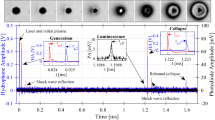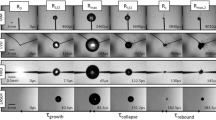Abstract
We describe a recently realized experiment producing the most spherical cavitation bubbles today. The bubbles grow inside a liquid from a point plasma generated by a nanosecond laser pulse. Unlike in previous studies, the laser is focussed by a parabolic mirror, resulting in a plasma of unprecedented symmetry. The ensuing bubbles are sufficiently spherical that the hydrostatic pressure gradient caused by gravity becomes the dominant source of asymmetry in the collapse and rebound of the cavitation bubbles. To avoid this natural source of asymmetry, the whole experiment is therefore performed in microgravity conditions (ESA, 53rd and 56th parabolic flight campaign). Cavitation bubbles were observed in microgravity (∼0 g), where their collapse and rebound remain spherical, and in normal gravity (1 g) to hyper-gravity (1.8 g), where a gravity-driven jet appears. Here, we describe the experimental setup and technical results, and overview the science data. A selection of high-quality shadowgraphy movies and time-resolved pressure data is published online.














Similar content being viewed by others
References
Akhatov I, Lindau O, et al (2001) Collapse and rebound of a laser-induced cavitation bubble. Phys Fluids 13(10):2805–2819
Antoine C (1888) Tensions des vapeurs; nouvelle relation entre les tensions et les temp ratures. Comptes Rendus des Sances de l’Acadmie des Sciences 107:681–837
Benjamin TB, Ellis AT (1966) The collapse of cavitation bubbles and the pressures thereby produced against solid boundaries. Phil Trans R Soc Lond A 260(1110):221–240
Blake JR (1988) The kelvin impulse—application to cavitation bubble dynamics. J Aust Math Soc B 30(Part 2):127–146
Blake JR, Keen GS, Tong RP, Wilson M (1999) Acoustic cavitation: the fluid dynamics of non-spherical bubbles. Philos T R Soc A 357(1751):251–267
Brenner M, Hilgenfeldt S, Lohse D (2002) Single-bubble sonoluminescence. Rev Mod Phys 74(2): 425–484
Brujan EA, Keen GS, Vogel A, Blake JR (2002) The final stage of the collapse of a cavitation bubble close to a rigid boundary. Phys Fluids 14(1):85–92
Byun KT, Kwak HY (2004) A model of laser-induced cavitation. Jpn J Appl Phys 43(2):621–630. doi:10.1143/JJAP.43.621
Cho C, Urquidi J, Gellene G, Wilse Robinson G (2001) Mixture model description of the t-, p dependence of the refractive index of water. J Chem Phys 114(7):3157–3162
Hasmatuchi V (2011) Hydrodynamics of a pump-turbine operating at off-design conditions in generating mode. PhD thesis, EPFL-LMH
Hickling R (1965) Nucleation of freezing by cavity collapse and its relation to cavitation damage. Nature 206:915–917. doi:10.1038/206915a0
Katz JI (1999) Jets from collapsing bubbles. Proc R Soc Lond A 455:323–328
Kobel P, Obreschkow D, Dorsaz N, De Bosset A, Farhat M (2009) Techniques for generating centimetric drops in microgravity and application to cavitation studies. Exp Fluids 47:39–48
Lauterborn W (1972) High-speed photography of laser-induced breakdown in liquids. Appl Phys Lett 21(1):27–29. doi:10.1063/1.1654204
Lauterborn W, Bolle H (1975) Experimental investigations of cavitation bubble collapse in the neighborhood of a solid boundary. J Fluid Mech 72:391–399
Lauterborn W, Kurz T (2010) Physics of bubble oscillations. Rep Prog Phys 73(10):106501. doi:10.1088/0034-4885/73/10/106501
Leighton TG, Cleveland RO (2010) Lithotripsy. Proc Inst Mech Eng H 224(2):317–342
Lim KY, Quinto-Su PA, et al (2010) Nonspherical laser-induced cavitation bubbles. Phys Rev E 81(1):016308. doi:10.1103/PhysRevE.81.016308
Mason TJ, Paniwnyk L, Lorimer JP (1996) The uses of ultrasound in food technology. Ultrason Sonochem 3(3):S253–S260. doi: 10.1016/S1350-4177(96)00034-X
Obreschkow D, Kobel P, Dorsaz N, de Bosset A, Nicollier C, Farhat M (2006) Cavitation bubble collapse inside liquid spheres in microgravity. Phys Rev Lett 97(9):094502
Obreschkow D, Dorsaz N, Kobel P, de Bosset A, Tinguely M, Field J, Farhat M (2011a) Confined shocks inside isolated liquid volumes: a new path of erosion? Phys Fluids Lett 23(10):101702. doi:10.1063/1.3647583
Obreschkow D, Tinguely M, Dorsaz N, Kobel P, de Bosset A, Farhat M (2011b) Universal scaling law for jets of collapsing bubbles. Phys Rev Lett 107:204501. doi:10.1103/PhysRevLett.107.204501
Obreschkow D, Bruderer M, Farhat M (2012) Analytical approximations for the collapse of an empty spherical bubble. Phys Rev E 85:066303. doi10.1103/PhysRevE.85.066303:, URL http://link.aps.org/doi/10.1103/PhysRevE.85.066303
Ohl CD, Arora M, Dijkink R, Janve V, Lohse D (2006) Surface cleaning from laser-induced cavitation bubbles. Appl Phys Lett 89(7):074102
Ohl CD, Kurz T, Geisler R, Lindau O, Lauterborn W (1999) Bubble dynamics, shock waves and sonoluminescence. Philos T R Soc A 357(1751):269–294
Philipp A, Lauterborn W (1998) Cavitation erosion by single laser-produced bubbles. J Fluid Mech 361:75–116
Plesset M, Chapman RB (1971) Collapse of an initially spherical vapor cavity in the neighborhood of a solid boundary. J Fluid Mech 47:283–290
Rayleigh L (1917) On the pressure developed in a liquid during the collapse of a spherical cavity. Philos Mag 34:94–98
Sato T, Tinguely M, Oizumi M, Farhat M (2013) Evidence for hydrogen generation in laser- or spark-induced cavitation bubbles. Appl Phys Lett 102(7):074105. doi:10.1063/1.4793193
Schnerr G, Sezal I, Schmidt S (2008) Numerical investigation of three-dimensional cloud cavitation with special emphasis on collapse induced shock dynamics. Phys Fluids 20(4):040703
Stokes G (1847) Notebook preserved in the Cambridge University Library, Add. MS. 7656. NB23
Suslick KS (1990) Sonochemistry. Science 247(4949):1439–1445
Tandiono, Ohl SW, Ow DSW, Klaseboer E, Wong VV, Dumke R, Ohl CD (2011) Sonochemistry and sonoluminescence in microfluidics. Proc Natl Acad Sci USA 108(15):5996–5998
Tinguely M (2013) The effect of pressure gradient on the collapse of cavitation bubbles in normal and reduced gravity. PhD thesis, Ecole Polytechnique Fédérale de Lausanne
Tinguely M, Obreschkow D, Kobel P, Dorsaz N, de Bosset A, Farhat M (2012) Energy partition at the collapse of spherical cavitation bubbles. Phys Rev E 86(4):046315. doi:10.1103/PhysRevE.86.046315
Tomita Y, Shima A (1990) High-speed photographic observations of laser-induced cavitation bubbles in water. Acustica 71(3):161–171
Vogel A, Busch S, Parlitz U (1996) Shock wave emission and cavitation bubble generation by picosecond and nanosecond optical breakdown in water. J Acoust Soc Am 100(1):148–165. doi:10.1121/1.415878
Vogel A, Noack J, et al (1999) Energy balance of optical breakdown in water at nanosecond to femtosecond time scales. Appl Phys B Lasers Opt 68:271–280
Wang QX, Blake JR (2010) Non-spherical bubble dynamics in a compressible liquid. Part 1. Travelling acoustic wave. J Fluid Mech 659:191–224. doi:10.1017/S0022112010002430
Wolfrum B, Kurz T, Mettin R, Lauterborn W (2003) Shock wave induced interaction of microbubbles and boundaries. Phys Fluids 15(10):2916–2922
Acknowledgments
This research was supported by the Swiss NSF (Grant No. 200020-116641 and PBELP2-130895) and the European Space Agency ESA.
Author information
Authors and Affiliations
Corresponding author
Rights and permissions
About this article
Cite this article
Obreschkow, D., Tinguely, M., Dorsaz, N. et al. The quest for the most spherical bubble: experimental setup and data overview. Exp Fluids 54, 1503 (2013). https://doi.org/10.1007/s00348-013-1503-9
Received:
Revised:
Accepted:
Published:
DOI: https://doi.org/10.1007/s00348-013-1503-9




